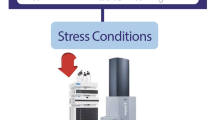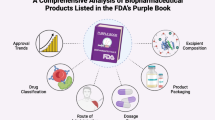ABSTRACT
The research was envisaged for development of time-controlled pulsatile release (PR) platform formulation to facilitate management of early morning chronological attacks. The development was started using prednisone as a model drug wherein core tablets were prepared using direct compression method and subsequently compression-coated with ethylcellulose (EC)-hydroxypropyl methylcellulose (HPMC) excipient blend. Initially, quality target product profile was established and risk assessment was performed using failure mode and effect analysis. In an endeavour to accomplish the objective, central composite design was employed as a design of experiment (DoE) tool. Optimised compression-coated tablet (CCT) exhibited 4–6 h lag time followed by burst release profile under variegated dissolution conditions viz. multi-media, change in apparatus/agitation and biorelevant media. Afterwards, five different drugs, i.e. methylprednisolone, diclofenac sodium, diltiazem hydrochloride, nifedipine and lornoxicam, were one-by-one incorporated into the optimised prednisone formula with replacement of former drug. Change in drug precipitated the issues like poor solubility and flow property which were respectively resolved through formulation of solid dispersion and preparation of active pharmaceutical ingredient (API) granules. Albeit, all drug CCTs exhibited desired release profile similar to prednisone CCTs. In nutshell, tour de force of research epitomised the objective of incorporating diverse drug molecules and penultimately obtaining robust release profile at varying dissolution conditions.






Similar content being viewed by others
REFERENCES
Mozaffarian D, Hao T, Rimm EB, Willett WC, Hu FB. Changes in diet and lifestyle and long-term weight gain in women and men. N Engl J Med. 2011;364:2392–404.
Smith JD, Hou T, Ludwig DS, Rimm EB, Willett W, Hu FB, et al. Changes in intake of protein foods, carbohydrate amount and quality, and long-term weight change: results from 3 prospective cohorts. Am J Clin Nutr. 2015;101:1216–24.
Steptoe A, Kivimäki M. Stress and cardiovascular disease: an update on current knowledge. Annu Rev Public Health. 2013;34:337–54.
Stetson B, Knight HM, Mokshagundam SPL. Nutrition and lifestyle change in older adults with diabetes mellitus and metabolic syndrome. In: Bales CW, Locher JL, Saltzman E, editors. Handbook of clinical nutrition and aging. New York: Springer; 2015. p. 179–202.
Gandhi B, Mundada A, Gandhi P. Chronopharmaceutics: as a clinically relevant drug delivery system. Drug Deliv. 2011;18:1–18.
Maroni A, Zema L, Del Curto MD, Loreti G, Gazzaniga A. Oral pulsatile delivery: rationale and chronopharmaceutical formulations. Int J Pharm. 2010;398:1–8.
Patil SS, Shahiwala A. Patented pulsatile drug delivery technologies for chronotherapy. Expert Opin Ther Pat. 2014;24:845–56.
Khan Z, Pillay V, Choonara YE, du Toit LC. Drug delivery technologies for chronotherapeutic applications. Pharm Dev Technol. 2009;14:602–12.
Ohdo S. Chronotherapeutic strategy: rhythm monitoring, manipulation and disruption. Adv Drug Deliv Rev. 2010;62:859–75.
Lin S-Y, Kawashima Y. Current status and approaches to developing press-coated chronodelivery drug systems. J Control Release. 2012;157:331–53.
Litinski M, Scheer FA, Shea SA. Influence of the circadian system on disease severity. Sleep Med Clin. 2009;4:143–63.
Youan BBC. Chronopharmaceutics: gimmick or clinically relevant approach to drug delivery. J Control Release. 2004;98:337–53.
Patadia R, Vora C, Mittal K, Mashru R. Investigating effects of hydroxypropyl methylcellulose (HPMC) molecular weight grades on lag time of press-coated ethylcellulose tablets. Pharm Dev Technol. 2015. doi:10.3109/10837450.2015.1055767.
Patadia R, Vora C, Mittal K, Mashru R. Investigating critical effects of variegated lubricants, glidants and hydrophilic additives on lag time of press coated ethylcellulose tablets. Pharm Dev Technol. 2016;21:302–10.
Schäcke H, Döcke WD, Asadullah K. Mechanisms involved in the side effects of glucocorticoids. Pharmacol Ther. 2002;96:23–43.
Maroni A, Zema L, Cerea M, Sangalli ME. Oral pulsatile drug delivery systems. Expert Opin Drug Deliv. 2005;2:855–71.
Bose S, Bogner RH. Solventless pharmaceutical coating processes: a review. Pharm Dev Technol. 2007;12:115–31.
Lin SY, Li MJ, Lin KH. Hydrophilic excipients modulate the time lag of time-controlled disintegrating press-coated tablets. AAPS PharmSciTech. 2004;5:25–9.
Rane AB, Gattani SG, Kadam VD, Tekade AR. Formulation and evaluation of press coated tablets for pulsatile drug delivery using hydrophilic and hydrophobic polymers. Chem Pharm Bull. 2009;57:1213–7.
Rujivipat S, Bodmeier R. Improved drug delivery to the lower intestinal tract with tablets compression-coated with enteric/nonenteric polymer powder blends. Eur J Pharm Biopharm. 2010;76:486–92.
Bussemer T, Otto I, Bodmeier R. Pulsatile drug-delivery systems. Crit Rev Ther Drug Carrier Syst. 2001;18:433–58.
Rowe RC, Sheskey PJ, Quinn ME. Handbook of pharmaceutical excipients. 6th ed. London: Pharmaceutical Press; 2009.
Lin SY, Lin KH, Li MJ. Influence of excipients, drugs, and osmotic agent in the inner core on the time‐controlled disintegration of compression‐coated ethylcellulose tablets. J Pharm Sci. 2002;91:2040–6.
Lawrence XY. Pharmaceutical quality by design: product and process development, understanding, and control. Pharmacol Res. 2008;25:781–91.
Lawrence XY, Amidon G, Khan MA, Hoag SW, Polli J, Raju GK, et al. Understanding pharmaceutical quality by design. AAPS J. 2014;16:771–83.
Lionberger RA, Lee SL, Lee L, Raw A, Lawrence XY. Quality by design: concepts for ANDAs. AAPS J. 2008;10:268–76.
Ahmed MO, Al-Badr AA. Lornoxicam. In: Harry GB, editor. Profiles of drug substances, excipients and related methodology. London: Academic; 2011. p. 205–39.
Al‐Habet SM, Rogers HJ. Methylprednisolone pharmacokinetics after intravenous and oral administration. Br J Clin Pharmacol. 1989;27:285–90.
Balfour JA, Fitton A, Barradell LB. Lornoxicam: a review of its pharmacology and therapeutic potential in the management of painful and inflammatory conditions. Drugs. 1996;51:639–57.
Buckley MM, Grant SM, Goa KL, McTavish D, Sorkin EM. Diltiazem. A reappraisal of its pharmacological properties and therapeutic use. Drugs. 1990;39:757–806.
Chuasuwan B, Binjesoh V, Polli J, Zhang H, Amidon G, Junginger H, et al. Biowaiver monographs for immediate release solid oral dosage forms: diclofenac sodium and diclofenac potassium. J Pharm Sci. 2009;98:1206–19.
Gajendran J, Krämer J, Shah VP, Langguth P, Polli J, Mehta M, et al. Biowaiver monographs for immediate-release solid oral dosage forms: nifedipine. J Pharm Sci. 2015;104:3289–98.
Scholz H. Pharmacological aspects of calcium channel blockers. Cardiovasc Drugs Ther. 1997;10:869–72.
Skjodt NM, Davies NM. Clinical pharmacokinetics of lornoxicam: a short half-life oxicam. Clin Pharmacokinet. 1998;34:421–8.
Sorkin EM, Clissold SP, Brogden RN. Nifedipine: a review of its pharmacodynamic and pharmacokinetic properties, and therapeutic efficacy, in ischaemic heart disease, hypertension and related cardiovascular disorders. Drugs. 1985;30:182–274.
Vogt M, Derendorf H, Krämer J, Junginger H, Midha K, Shah V, et al. Biowaiver monographs for immediate release solid oral dosage forms: prednisone. J Pharm Sci. 2007;96:1480–9.
British Pharmacopoeia. London: the stationery office on behalf of the Medicines and Healthcare products Regulatory Agency (MHRA); 2009.
Moffat AC, Osselton MD, Widdop B. Clarke’s analysis of drugs and poisons. 3rd ed. London: Pharmaceutical Press; 2004.
Mazzo DJ, Obetz CL, Shuster J. Diltiazem hydrochloride. In: Harry GB, editor. Analytical profiles of drug substances and excipients. London: Academic; 1994. p. 53–98.
Tapia C, Montezuma V, Yazdani-Pedram M. Microencapsulation by spray coagulation of diltiazem HCl in calcium alginate-coated chitosan. AAPS Pharm Sci Tech. 2008;9:1198–206.
Plumley C, Gorman EM, El-Gendy N, Bybee CR, Munson EJ, Berkland C. Nifedipine nanoparticle agglomeration as a dry powder aerosol formulation strategy. Int J Pharm. 2009;369:136–43.
Hamza YE-S, Aburahma MH. Design and in vitro evaluation of novel sustained-release matrix tablets for lornoxicam based on the combination of hydrophilic matrix formers and basic pH-modifiers. Pharm Dev Technol. 2010;15:139–53.
Shakeel F, Haq N, Alanazi FK, Alsarra IA. Solubility of anti-inflammatory drug lornoxicam in ten different green solvents at different temperatures. J Mol Liq. 2015;209:280–3.
ICH Q8 (R2), Pharmaceutical development. ICH harmonised tripartite guideline, 2009. http://www.ich.org/fileadmin/Public_Web_Site/ICH_Products/Guidelines/Quality/Q8_R1/Step4/Q8_R2_Guideline.pdf. Accessed 15 Jun 2016.
ICH Q9, Quality risk management. ICH harmonised tripartite guideline, 2005. http://www.ich.org/fileadmin/Public_Web_Site/ICH_Products/Guidelines/Quality/Q9/Step4/Q9_Guideline.pdf. Accessed 15 Jun 2016.
Hiyama Y. 2009. Quality overall summary mock P2 (Description examples). March 2009. http://www.nihs.go.jp/drug/section3/English%20Mock%20QOS%20P2%20R.pdf. Accessed 15 Jun 2016.
Vora C, Patadia R, Mittal K, Mashru R. Risk based approach for design and optimization of stomach specific delivery of rifampicin. Int J Pharm. 2013;455:169–81.
Vora C, Patadia R, Mittal K, Mashru R. Risk based approach for design and optimization of site specific delivery of isoniazid. J Pharm Invest. 2015;45:249–64.
ICH Q2 (R1), Validation of analytical procedures: text and methodology. ICH harmonised tripartite guideline, 2005. http://www.ich.org/fileadmin/Public_Web_Site/ICH_Products/Guidelines/Quality/Q2_R1/Step4/Q2_R1__Guideline.pdf. Accessed 15 Jun 2016.
United States Pharmacopoeia (USP37-NF32). Rockville, MD: The United States Pharmacopoeial Convention Inc; 2014.
Verma RK, Garg S. Selection of excipients for extended release formulations of glipizide through drug–excipient compatibility testing. J Pharm Biomed Anal. 2005;38:633–44.
Cohen JL, Hubert BB, Leeson LJ, Rhodes CT, Robinson JR, Roseman TJ, et al. The development of USP dissolution and drug release standards. Pharm Res. 1990;7:983–7.
Patadia R, Vora C, Mittal K, Mashru R. Dissolution criticality in developing solid oral formulations: from inception to perception. Crit Rev Ther Drug Carrier Syst. 2013;30:495–534.
ICH Q1A (R2), Stability testing of new drug substances and products. ICH harmonised tripartite guideline, 2003. http://www.ich.org/fileadmin/Public_Web_Site/ICH_Products/Guidelines/Quality/Q1A_R2/Step4/Q1A_R2__Guideline.pdf. Accessed 15 Jun 2016.
ICH Q3C (R5), Impurities: guideline for residual solvents. ICH harmonised tripartite guideline, 2011. http://www.ema.europa.eu/docs/en_GB/document_library/Scientific_guideline/2011/03/WC500104258.pdf. Accessed 15 Jun 2016.
Hao J, Wang F, Wang X, Zhang D, Bi Y, Gao Y, et al. Development and optimization of baicalin-loaded solid lipid nanoparticles prepared by coacervation method using central composite design. Eur J Pharm Sci. 2012;47:497–505.
Response surface methodology. In: Lewis GA, Mathieu D, Phan-Tan-Luu R, Editors. Pharmaceutical experimental design. New York: Marcel Dekker; 1999.
Process Improvement. Engineering Statistics Handbook. NIST/SEMATECH: US Department of Commerce, 2013. http://www.itl.nist.gov/div898/handbook/pri/section3/pri3361.htm. Accessed 15 Jun 2016.
Singh B, Dahiya M, Saharan V, Ahuja N. Optimizing drug delivery systems using systematic “design of experiments.” Part II: retrospect and prospects. Crit Rev Ther Drug Carrier Syst. 2005;22:215–94.
Singh B, Garg B, Chaturvedi SC, Arora S, Mandsaurwale R, Kapil R, et al. Formulation development of gastroretentive tablets of lamivudine using the floating‐bioadhesive potential of optimized polymer blends. J Pharm Pharmacol. 2012;64:654–69.
Singh B, Kapil R, Nandi M, Ahuja N. Developing oral drug delivery systems using formulation by design: vital precepts, retrospect and prospects. Expert Opin Drug Deliv. 2011;8:1341–60.
Singh B, Kumar R, Ahuja N. Optimizing drug delivery systems using systematic “design of experiments.” Part I: fundamental aspects. Crit Rev Ther Drug Carrier Syst. 2005;22:27–105.
Schwartz JB, O’Connor RE, Schnaare RL. Optimization techniques in pharmaceutical formulation and processing. In: Banker GS, Rhodes CT, editors. Modern pharmaceutics. 4th ed. New York: Marcel Dekker; 2002.
Anand O, Lawrence XY, Conner DP, Davit BM. Dissolution testing for generic drugs: an FDA perspective. AAPS J. 2011;13:328–35.
Gunsel WC, Ducel RG. Compression-coated and layer tablet. In: Lieberman HA, Lachman L, Schwartz B, editors. Pharmaceutical dosage forms: tablets, vol-1. 2nd ed. New York: Marcel Dekker; 1989. p. 247–84.
Ozeki Y, Ando M, Watanabe Y, Danjo K. Evaluation of novel one-step dry-coated tablets as a platform for delayed-release tablets. J Control Release. 2004;95:51–60.
ACKNOWLEDGEMENTS
Mr. Riddhish Patadia is highly grateful to the University Grants Commission, Government of India, New Delhi for availing senior research fellowship. The authors are thankful to the industries that provided gift samples. We appreciate Metallurgical and Materials Engineering Department, Faculty of Technology and Engineering, The M.S. University of Baroda, Vadodara 390001, India for insightful assistance in PXRD study. We are also thankful to the Electrical Research and Development Association, Vadodara 390010, India for extending support for SEM analysis.
Author information
Authors and Affiliations
Corresponding author
Ethics declarations
Conflict of Interest
The authors declare no conflict of interest related to this work.
ELECTRONIC SUPPLEMENTARY MATERIAL
Below is the link to the electronic supplementary material.
Supplementary S1
(DOCX 16.1 kb)
Supplementary S2
(DOCX 502 kb)
Supplementary S3
(DOCX 1.38 mb)
Supplementary S4
(DOCX 313 kb)
Rights and permissions
About this article
Cite this article
Patadia, R., Vora, C., Mittal, K. et al. Quality by Design Empowered Development and Optimisation of Time-Controlled Pulsatile Release Platform Formulation Employing Compression Coating Technology. AAPS PharmSciTech 18, 1213–1227 (2017). https://doi.org/10.1208/s12249-016-0590-3
Received:
Accepted:
Published:
Issue Date:
DOI: https://doi.org/10.1208/s12249-016-0590-3




